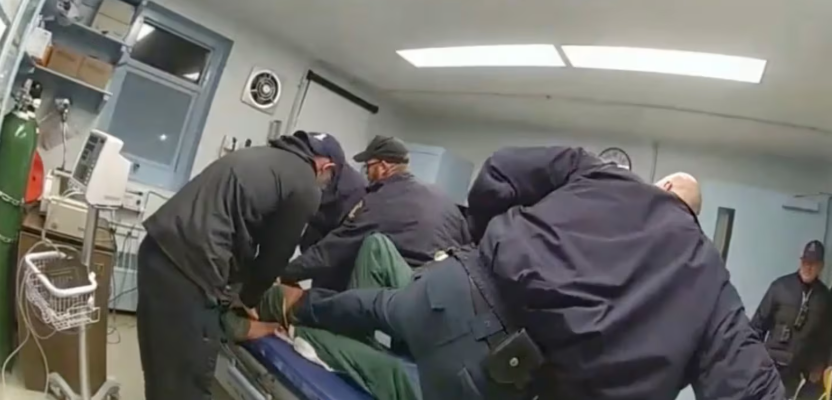Introduction: A Glimpse Into Systemic Failures
New York a harrowing revelation that has sparked outrage across the United States, body camera footage released this week shows a prisoner in a New York correctional facility being fatally beaten by correctional officers while in handcuffs. The footage, released as part of an ongoing investigation, raises serious questions about the excessive use of force, systemic issues within the U.S. prison system, and the failure to protect vulnerable individuals in state custody.
The violent incident not only underscores issues of accountability within law enforcement agencies but also fuels the larger discourse around prison reform, human rights, and institutional abuses.
The Incident: A Brutal Encounter Behind Bars
The newly released footage reveals disturbing details of the altercation between correctional officers and the deceased prisoner. The prisoner, whose identity has been withheld pending notification of his family, was already restrained in handcuffs when officers began to physically assault him.  For the more information click on this link
For the more information click on this link
Events Captured in the Footage
- The Initial Confrontation: According to the video, correctional officers entered the cell and engaged in a heated verbal altercation with the prisoner. Moments later, one officer struck him, sparking a cascade of violence.
- Physical Assault: Despite the prisoner being restrained, the footage shows multiple officers pummeling him repeatedly. The blows targeted the head and torso, even as the prisoner appeared defenseless.
- Aftermath: Following the beating, the prisoner was dragged from his cell, bleeding and unconscious. Despite visible injuries, immediate medical attention was not provided, further exacerbating the gravity of the situation.
Cause of Death
Preliminary reports indicate that the prisoner succumbed to blunt force trauma, consistent with the events depicted in the footage. The incident is now classified as a custodial death under suspicious circumstances.
Family and Public Reaction: Grief and Outrage
The family of the deceased has condemned the incident, calling for justice and transparency. In an emotional statement, the victim’s family demanded criminal charges against the officers involved and a broader investigation into systemic abuses within the correctional facility.
Public Backlash
- Protests and Demonstrations: Advocacy groups, human rights organizations, and concerned citizens have staged protests outside the prison and New York City Hall, calling for immediate reforms in correctional practices.
- Social Media Outcry: The footage has gone viral online, amplifying public anger and reigniting debates around police and prison brutality.
Systemic Failures Highlighted by the Incident
The fatal beating in custody underscores a troubling pattern of systemic failures within the U.S. penal system.
1. Excessive Use of Force
The incident exemplifies unchecked aggression by law enforcement personnel. Experts highlight the need for clearer guidelines on the use of force, particularly involving restrained individuals.
2. Lack of Oversight and Accountability
Despite the widespread availability of surveillance and body cameras, abuses remain prevalent:
- Limited Oversight: Incidents often go unreported or unpunished due to internal biases within correctional institutions.
- Accountability Gaps: Disciplinary actions against offending officers are rare, and prosecutions even rarer.
3. Human Rights Violations
The treatment of the prisoner contravenes international human rights standards, including the United Nations’ “Standard Minimum Rules for the Treatment of Prisoners” (the Nelson Mandela Rules), which emphasize humane treatment regardless of an individual’s offense.
4. Health and Safety Concerns
Failure to administer timely medical attention highlights the negligence pervasive in correctional facilities, often resulting in preventable deaths.
Historical Context: Patterns of Custodial Abuse in the U.S.
The New York incident is far from an isolated case. Custodial violence has plagued the U.S. prison system for decades, pointing to entrenched cultural and structural problems.
High-Profile Cases of Custodial Violence
- Kalief Browder (2015): The teenager committed suicide after years of mistreatment at Rikers Island, sparking widespread calls for reform.
- Ronald Greene (2020): Body camera footage showed police officers beating and dragging the unarmed Black man during an arrest, despite official reports claiming he died in a car accident.
Statistics on Custodial Deaths
Reports by watchdog organizations reveal that custodial deaths in the U.S. frequently result from excessive force, negligence, or failure to follow protocol:
- Between 2010 and 2020, over 7,500 custodial deaths were reported nationwide.
- Studies show that minorities, particularly Black and Hispanic individuals, New York disproportionately face violence in custody.
Legal and Institutional Responses
Current Investigation
New York State officials have pledged a thorough investigation into the prisoner’s death. Measures include:
- Officer Suspensions: Several correctional officers have been placed on administrative leave pending further inquiry.
- Independent Review: The Attorney General’s office, alongside an independent watchdog, New York has assumed oversight of the case.
Criminal Charges
Advocacy groups are pressing for charges including second-degree murder, aggravated assault, New York and violations of civil rights statutes.
Federal Intervention
The U.S. Department of Justice is reportedly monitoring the case, and federal intervention is likely if state-level investigations are perceived as inadequate.
Advocacy for Reform: Policy Recommendations
The incident has intensified calls for sweeping reforms in the American correctional system. Experts and activists propose several measures:
1. Strengthening Oversight Mechanisms
- Independent monitoring bodies should oversee correctional institutions to investigate abuses impartially.
- Establishment of civilian review boards to hold staff accountable.
2. Enhancing Training Programs
- Emphasis on de-escalation techniques and non-violent conflict resolution.
- Regular assessments to ensure adherence to ethical standards.
3. Mandating Body Cameras
- Nationwide implementation of mandatory body cameras for all officers in correctional settings.
- Real-time monitoring to ensure compliance with protocols.
4. Ensuring Timely Medical Attention
- Immediate medical intervention protocols must be made mandatory after use-of-force incidents.
- Oversight to ensure prison healthcare providers act independently of corrections staff.
5. Broader Prison Reforms
Advocates argue that addressing violence requires systemic change, New York including reducing prison populations and emphasizing rehabilitation over punishment.
Public Mobilization and the Role of Media
Media as a Catalyst for Change
The release of body camera footage highlights the importance of transparency and public accountability. Media coverage of incidents like this compels authorities to act, New York spurs policy change, and provides a platform for survivors and advocates to voice their demands.  For the more information click on this link
For the more information click on this link
Grassroots Movements
Organizations like the ACLU, NAACP, and Black Lives Matter are leveraging the moment to push for legislation aimed at curbing abuses and improving transparency in correctional facilities.
Conclusion: Demanding Justice and Ensuring Change
The death of a handcuffed prisoner at the hands of New York correctional officers serves as a grim reminder of the violence and neglect permeating America’s prison system. Body camera footage has brought this brutal incident to light, ensuring it cannot be ignored or downplayed.
However, awareness alone is insufficient. Achieving justice for the victim, New York holding perpetrators accountable, and ensuring long-overdue systemic reforms must be the primary focus moving forward. For a nation that prides itself on the rule of law, nothing less will suffice.
Through collective action, robust policies, New York and an unwavering commitment to human rights, this tragedy can serve as a turning point, inspiring substantive change within the criminal justice system and ensuring no life is devalued behind bars again. ALSO READ:- Israeli Airstrikes Target Yemen Airport Amid Rising Tensions: Civilians Caught in Crossfire 2024




